Landscapes are alive and in constant flux. Some lucky ones are still untouched while a large portion is infiltrated and is hostage to the ever growing demands of mankind. The whole ideology of man coexisting with nature is taken for granted and forgotten. We’ve been taking hold of landscapes as if they belong to serve our needs. Villages are expanding to become towns, towns to become cities, Cities to urban sprawls. In the process, there is complete disregard for loss of the inherent quality of a landscape. Thus, going through a transformation that completely changes the orientation of the landscape. A horizontal sweep of land experiences a sudden uprising. Geometric structures contradicting and negating the organic forms creates a divide. This divide comes up so gradually that we turn a blind eye to it in helplessness.
Sikkim (a mountainous region in North East India) is a place that I’ve frequented ever since childhood. In the later times there was a conscious observation of how the landscape there has transformed due to the boom in the tourism economy. An ironical situation really. The very landscapes which the tourism industry feeds on, has been eaten out by the industry itself. Once a serene uninhabited landscape has now been flooded with hotels, shopping complexes, food joints and other establishments. A land rich in its flora and fauna, mountainous terrain, and its ability to create a sense of solitude is gradually losing its charm.
I further associate Sikkim to the idea of Shangri la, a mythical kingdom, considered as a mountainous paradise devoid of any troubles associated with civilization. This series of works envisions a Himalayan utopia eventually turning into an urban utopia. Juxtaposed in such a way that it almost looks dystopic. A region, supposed to stay hidden/aloof from civilization has been infiltrated and taken over by urban structures which is creeping its way into the originally solitary landscape. The dystopic visuals suggest the presence of human beings in their absence.
All the original photographs are documentations of Sikkim which I’ve further manipulated by hand to put forward the idea mentioned above.
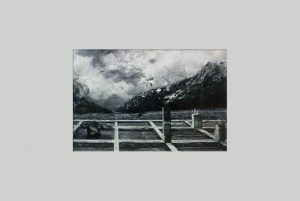
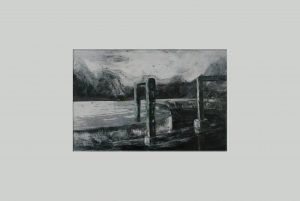
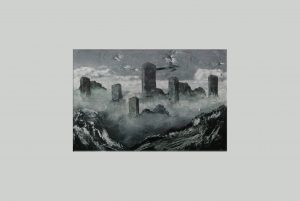

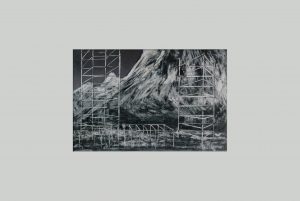
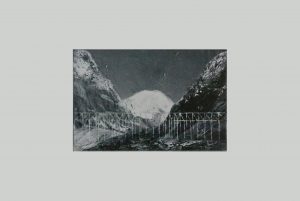
I want to delve deeper into the idea of transformation of landscapes and see what possibilities it can open up for me. Feel free to critique and comment.
Below is the link to my vimeo page where you can find out a little about what I've worked on previously:-
https://vimeo.com/user57072690

Hello Pranay,
I checked the link you provided and am interested to know more about your video series entitled Volatile. How are these videos be displayed? Are they be projected side by side and played in loops? Have you also thought about create videos based on your photo documentation of Sikkim? It would be cool to see some video elements/animated figures appear in your urban utopia photos, like how Matte Painting Video shows a fictional space with time frames. For example, it would be fascinating to see some excavator working in the field and people hang around with dogs on the road with the mountainous paradise in the background. – Dengke
Hi Dengke, I’m glad you went through my vimeo page. The ‘volatile’ series was a comparatively earlier work. Yes I intended on projecting them side by side, simultaneously on loop. Also I’d planned on accompanying them with photographs. I have also planned on doing a parallel video project based on the photo documentation of Sikkim. I consciously try and keep my work void of human beings. I want my viewers to concentrate primarily on the landscapes via which they can get a feeling of human presence without them being there. I feel the moment I involve human beings into the frame, they seem to take up a lot of attention and individual stories come into the mind based on what the human beings are doing. I want my viewers to see the landscapes as a whole and imagine or derive from the imagery as to what what it must have gone through. Although I will consider incorporating other elements into play as well so that viewer can form a sort of narrative as to how the landscapes must’ve changed. Thanks again for the suggestion and interest.
Thank you Pranay, for your insights. I appreciate the points you make about humans inability to symbiotically coexist with nature. While we fight for basic human rights, there will be no one to fight for the rights of the earth. With population growth and resource bottlenecks, humans will acquire the remaining land to fulfill our needs. Whether or not it is done responsibly, it will still be erasing the untouched utopia that once was. That original form of beauty will be marred. What I wonder is, as an observer, what your message is to your audience. Do you want viewers to alter their perspectives to be at peace with the inevitable change you are presenting, influence preservation of natural habitats so the semblance of their existence is not erased, or connect on the shared experience of your firsthand account? Speaking to the opportunities a deeper study of these transformations will present for you, what direction do you see your work taking next?
Thank you Uji Venkat for bringing forth the question of what my message to my audience would be. Being brutally honest, I’d say that I really didn’t think much about what response I am looking for through this project. I feel that the more I think about the others, it becomes lesser about the self. I kept reworking the uninhabited landscapes of Sikkim that used to be in solitude, by introducing and building up man made structures in the space. Tried elaborating on a contradictory mood in the existing environment. I portrayed the space the way I saw it changing over time. I hope my audience can experience the transformation of space the way I see it. Desolated but puts forward a sense of infiltration of space that it’s been through. Although, I will say that I would want my viewers to reflect upon this transformation negatively. See how drastically it changes the way we look at uninhabited land around us. Acting upon it is not within my reach but making someone feel about the the loss of such moving landscapes is something I aim for. Please let me know if or if not that suffices your query.
Thank you Ushmita for responding to my concerns and sharing works of those artists who are working with the environment. I agree that pointing out at economical growth as the causing factor for degradation of landscapes is not an easy accusation to make. Fundamental rights of human being are obviously in question. Although, in regards to my work and practice, I am not really aiming at a remedial tangent. But rather taking the position of a observer, spectator, or flaneur in some sense. I’m not really keen on making political statements but rather foreseeing or imagining what shangri-la, a land devoid of any man related troubles, would look like if it were infiltrated. How it would rather look dystopic, introducing urban structure into a wild and untamed mountain range
“The dystopic visuals suggest the presence of human beings in their absence.”
Your photographs do make me feel this. It is interesting to see how you have taken the idea and translated it through your photographs to arouse a disturbing feeling, the same uneasiness and restlessness one feels when encountering a changing landscape, or rather a dissolving landscape.
I can relate it to the area I’m staying in Delhi where the locality is actually an illegal construction built by clearing the forest area, and also parts being converted into garbage dumping grounds. When I look outside my balcony I see this beautiful forest, and as soon as I look down there are clusters of garbage. It is such a disturbing sight to have the rising garbage and the forest in the same frame, and I can see the forest slowly succumbing to this pollution, transforming into a dystopic landscape. As you said, the presence of human beings in their absence can be felt very strongly here.
Thank you Sonam. I’m glad you reciprocate to the same feeling that such transforming landscapes generate. When I visited Sikkim this year I experienced a major change. The very same places that were still untouched by civilization were now flooded with a variety of establishments. It completely altered my perception. Disturbed the remains of the place that existed in my memory. This uneasiness pushed me to take this project up and represent it the way that it affected me.
Thank you, Pranay for sharing your concerns about transforming landscapes. As a resident of small Indian university town, I too am aware what rampant and unplanned construction can do to the infrastructure of any space and is proven counterproductive in the long run. Yet the situation is not that easy, political and economic marginalisation of any area, even if it s for its natural beauty, is denying them basic human rights. What is perhaps needed is planned growth. And this is where the failing lies. As there is no master plan for planned development from the government at local levels, business/political nexus take over. Real estate is big money and at end of the day, avarice wins. Consequently, the development in the Himalayas lacks coherence causing degradation of the environment, deforestation, soil erosion, floods, poverty, out-migration, loss of biodiversity and cultural heritage, the vanishing of traditional systems of community management, alienation of and deprivation of benefits to mountain people. To end the political and economic marginalization of the Himalayas and its people, policies, laws and instruments with specific mountain focus are needed to be developed both at National and Local levels.
Regarding your own practice, as an artist responding to these issues, I am sharing a link about artists who are working on similar concepts. http://www.huffingtonpost.in/entry/environmental-art_n_5585288